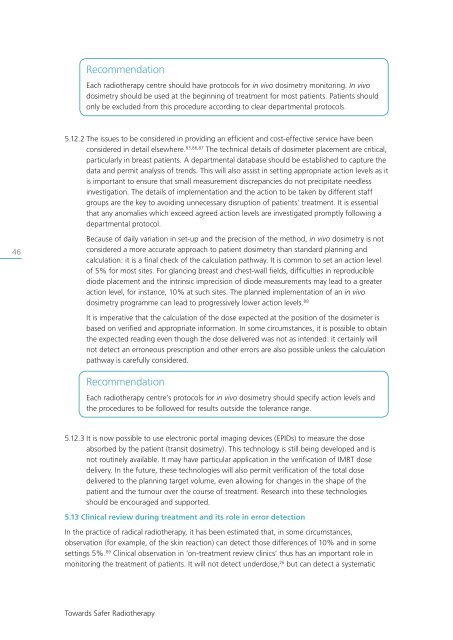Towards Safer Radiotherapy
Towards Safer Radiotherapy
Towards Safer Radiotherapy
You also want an ePaper? Increase the reach of your titles
YUMPU automatically turns print PDFs into web optimized ePapers that Google loves.
Recommendation<br />
Each radiotherapy centre should have protocols for in vivo dosimetry monitoring. In vivo<br />
dosimetry should be used at the beginning of treatment for most patients. Patients should<br />
only be excluded from this procedure according to clear departmental protocols.<br />
5.12.2 The issues to be considered in providing an efficient and cost-effective service have been<br />
considered in detail elsewhere. 83,86,87 The technical details of dosimeter placement are critical,<br />
particularly in breast patients. A departmental database should be established to capture the<br />
data and permit analysis of trends. This will also assist in setting appropriate action levels as it<br />
is important to ensure that small measurement discrepancies do not precipitate needless<br />
investigation. The details of implementation and the action to be taken by different staff<br />
groups are the key to avoiding unnecessary disruption of patients’ treatment. It is essential<br />
that any anomalies which exceed agreed action levels are investigated promptly following a<br />
departmental protocol.<br />
46<br />
Because of daily variation in set-up and the precision of the method, in vivo dosimetry is not<br />
considered a more accurate approach to patient dosimetry than standard planning and<br />
calculation: it is a final check of the calculation pathway. It is common to set an action level<br />
of 5% for most sites. For glancing breast and chest-wall fields, difficulties in reproducible<br />
diode placement and the intrinsic imprecision of diode measurements may lead to a greater<br />
action level, for instance, 10% at such sites. The planned implementation of an in vivo<br />
dosimetry programme can lead to progressively lower action levels. 88<br />
It is imperative that the calculation of the dose expected at the position of the dosimeter is<br />
based on verified and appropriate information. In some circumstances, it is possible to obtain<br />
the expected reading even though the dose delivered was not as intended: it certainly will<br />
not detect an erroneous prescription and other errors are also possible unless the calculation<br />
pathway is carefully considered.<br />
Recommendation<br />
Each radiotherapy centre’s protocols for in vivo dosimetry should specify action levels and<br />
the procedures to be followed for results outside the tolerance range.<br />
5.12.3 It is now possible to use electronic portal imaging devices (EPIDs) to measure the dose<br />
absorbed by the patient (transit dosimetry). This technology is still being developed and is<br />
not routinely available. It may have particular application in the verification of IMRT dose<br />
delivery. In the future, these technologies will also permit verification of the total dose<br />
delivered to the planning target volume, even allowing for changes in the shape of the<br />
patient and the tumour over the course of treatment. Research into these technologies<br />
should be encouraged and supported.<br />
5.13 Clinical review during treatment and its role in error detection<br />
In the practice of radical radiotherapy, it has been estimated that, in some circumstances,<br />
observation (for example, of the skin reaction) can detect those differences of 10% and in some<br />
settings 5%. 89 Clinical observation in ‘on-treatment review clinics’ thus has an important role in<br />
monitoring the treatment of patients. It will not detect underdose, 26 but can detect a systematic<br />
<strong>Towards</strong> <strong>Safer</strong> <strong>Radiotherapy</strong>



